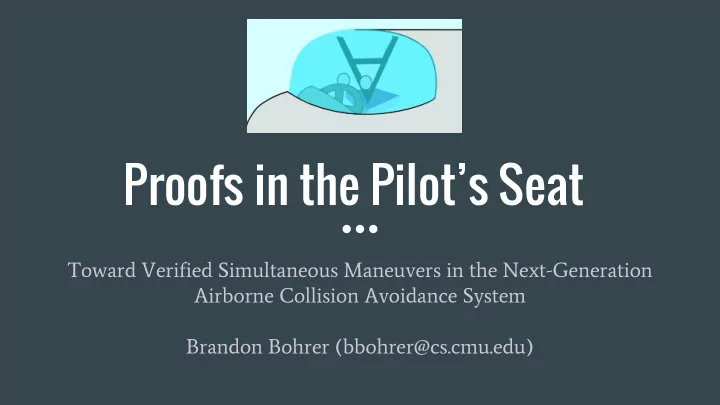

Proofs in the Pilot’s Seat Toward Verified Simultaneous Maneuvers in the Next-Generation Airborne Collision Avoidance System Brandon Bohrer (bbohrer@cs.cmu.edu)
Who Came Here By Plane?
Want to Get Home Alive?
Background: Collision Avoidance Onboard collision avoidance offers last-minute advice to pilots ● Aircraft remains under human control ● Current Generation: TCAS ● Next Generation: ACAS X ● Enable denser airspace by reducing spurious alerts ○ Improve safety beyond levels achieved by TCAS ○ Image Source: FlySafe Project - http://www.eu-flysafe.org/Project/Aviation- Hazards/Air-Traffic/current-systems.html 4
Background: ACAS X Verification ACAS X implementation extremely large ● Lookup table with millions of states ○ ACAS X output extremely simple ● One of twelve maneuvers ○ Idea: Verify correctness of output , not implementation . ● Verification approach: ● Exhaustive testing (cover entire lookup table) ○ ○ Compute safe maneuvers for each state Compare with ACAS X output ○ ○ Verify correctness of “safe maneuvers” computation 5
Using Verification in the Implementation Problem: Not all ACAS X bugs easily fixed by changing lookup table ● Solution: Use safety analysis in production to provide safer advice ● ● Compare ACAS X result with list of safe maneuvers If given unsafe maneuver when safe one exists, change it! ● Problem: Really need to trust the safety analysis ● Need to generalize previous verification results ● 6
Project: Verified Simultaneous Maneuvers Prior work (by others): Assumes intruder aircraft moves in straight line. ● What if both aircraft are equipped with ACAS X? ● What if intruder aircraft makes evasive maneuvers? ● What if intruder aircraft behaves randomly? ● Solution: Model encounters where both aircraft maneuver ● 7
Modeling: Dynamics Assumption: Aircraft flying head-on ● Assumption: ● Constant horizontal velocity Vertical acceleration changes discretely ● Vertical trajectory: ● Sequence of parabolas Differential Equation: ● r' = -vr, ○ Image Source: [JBJ2105] h' = v, v' = a, hi' = vi, vi' = ai 8
(Prior Work) Modeling: Maneuvers Bounds a_min <= a <= a_max obeyed at all times ● Target velocity range v_min <= v <= v_max ● Accelerate with acceleration a_a or a_b to achieve desired velocity ● 9
Contribution: Safe Regions Maneuver safe iff ownship is always above or always below intruder ● Compute acceleration lower bound a_lo ● “Is the aircraft forced to accelerate upward?” ○ Compute acceleration upper bound a_up in {a_max, a_a} ● “Is the aircraft forced to accelerate downward?” ○ At all points in trajectory, ownship and intruder bounds separated ● Image Source: [JBJ2105] 10
Contribution: Proof Always above intruder vs. always below intruder (2 cases) ● Constraints on a_lo, a_up? (4 cases) ● Is each trajectory quadratic or linear? (4 cases) ● In total: 2 * 2 * 4 = 32 cases ● Each case: First-order arithmetic problems ● Use custom tactic library for arithmetic proofs ● Current progress: 2 - epsilon cases (this proof is hard) ● Third case somewhat harder ○ Many other cases are symmetric ○ 11
Proof Example: Linear-Quadratic Case 12
References A Formally Verified Hybrid System for Safe Advisories in the Next-Generation ● Airborne Collision Avoidance System. Jean-Baptiste Jeannin, et. al. Manuscript, November 2015 Yanni Kouskoulas, et. al. Safe advisories for ACAS X in the presence of curved ● trajectories and non-deterministic intruder behavior. Unpublished Work (in progress), 2016. Mykel J. Kochenderfer and James P. Chryssanthacopoulos. Robust airborne ● collision avoidance through dynamic programming. Project Report ATC-371, MIT Lincoln Laboratory, 2011. 13
Recommend
More recommend